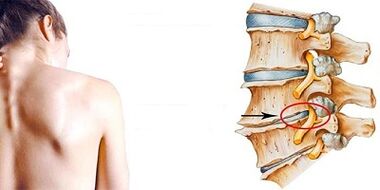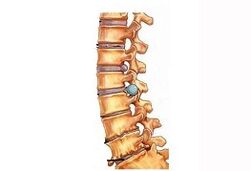Dizziness, pressure fluctuations, seizures, heart pain - all this often goes from problems with the spine.80% of the population suffers from osteochondrosis of the cervical region with varying severity and, according to statistics, men are confronted with women: 45-50 years.If you do not start treatment at an early stage, the pathology becomes irreversible.
What is osteochondrosis
The pathology is associated with dystrophic changes in cartilage between the vertebrae, in which the soft tissue becomes firm and falls depreciation.
Osteochondrosis affects the thoracic area, lumbar, but more often the rest - the cervix.The reason is for large loads of 1-7 vertebrae, weak muscles, poor nutrition and choice of the wrong sleep pillow.
The mechanism of damage to the cervical region of the cervical

Osteochondrosis develops when the process of feeding cartilage, mineral metabolism is impaired.The power of bones and joints falls, the connections lose their elasticity.The shape and structure of the disc change, under the influence of loads it is destroyed.The vertebrae are collected together, their surfaces are wiped off.Pathology causes such complications:
- The closure of blood vessels passing through 1-7 vertebrae causes hypoxia (oxygen starvation) of the brain.
- The development of problems in the operation of the respiratory system, blood vessels, heart, declines in vision.
- Disruption of the blood circulation of the brain leads to a neurocirculatory (vegetative-vascular) dystonia.
- Reduction of neck mobility - in the formation of bone formations on the vertebrae.
- Disruption of cerebral function, spinal cord compression - leads to death with an advanced stage of the disease.
Stages of cervical osteochondrosis
The pathology is slowly developing.At the pre -clinical stage, the distance between the vertebrae decreases, they press on a soft disk.Then it gets smaller, the fibrous ring is destroyed, its nucleus beats.A convexity is formed, then the hernia.The vertebrae and one another change the shape, the outgrowths appear on them.The nerves, the blood vessels are pressed.
The initial stage of osteochondrosis of the cervical region
The appearance of cracks occurs in the fibrous ring, the capsule breaks, the jacket is damaged.Cervical osteochondrosis is felt when the head turns, when the nerve endings are pressed, the vessels are narrow and the bloodstream suffers.There are pain in the back of the head, the muscles of the back are quickly tired.
2 stages of pathology
The degenerative process in the discs develops, the capsule is completely destroyed.The height between the vertebrae is reduced, they become unstable and squeeze the nerve roots of the spinal cord.The flexibility and mobility of the neck falls.At this stage, the disease is still treated without surgery.
The last stages of osteochondrosis of the neck

In the 3rd stage of the pathology, the bulge of the disc develops, leading to hernia, the pulpne ring protrudes and Burtez.The cervical vertebrae and their axis are shifted, the nutrition of the brain suffers.In addition, the following processes begin on the last (3 and 4) stages of pathology:
- Intervertebral discs are destroyed, which replaces connective tissue;
- The mobility of the cervix and shoulder joints disappears;
- From the friction of the surface of the vertebrae, outgrowths are formed, the nerve fibers are injured;
- The sensitivity of the hands falls due to problems with their innervation.
Symptoms of osteochondrosis of the cervical spine
The patient's condition depends on the stage of the disease.First, rare pain occurs when the head is rotated or lower, the tension of the posterior muscles.After a person experiences constant fatigue.The pain becomes more severe and more frequent.In addition, weakness, dizziness, rings in the ears are added, the visual acuity falls.All signs of osteochondrosis of the cervical spine are divided into 3 groups:
- Scattered syndromes-Nurodystrophic, muscle tonic and vegetative vascular manifestations.
- Compression-brown- are associated with compression of nerve endings, one of the key symptoms is acute pain when rotating the head.
- Vail Arttery Syndrome- It occurs when the vessel is narrowed, which feeds the structure of the brain.
Neurotic disorders
The brain is poorly supplied with blood, its function and the condition of the nervous system are disturbed.Often the head hurts, insomnia pain, which causes a state of fatigue, apathy.After the onset of symptoms:

- increased sweating;
- Emotional lability (mood instability);
- increased irritability;
- dizziness;
- depression;
- impaired concentration of attention;
- tinnitus;
- "Flies" in front of the eyes;
- concern;
- tremor (trembling) of the limbs;
- panic attacks;
- Vestibular disorders: nausea, vomiting, gait instability, space disorientation, impaired coordination.
General clinical signs
Osteochondrosis of the cervical vertebrae causes headaches, visual impairment.At 2 stages of the pathology, patients complain of ringing in the ears, lump in the throat, weakness of the muscles of the hands, tingling of the tongue.When the neck is rotated and the tilting of the head, a crunch is heard, black spots appear in front of the eyes.With spinal artery syndrome, other symptoms appear:
- Migraine that passes from the back of the head to the forehead;
- darkening in front of the eyes;
- Scalp soreness;
- hearing loss;
- increase in blood pressure;
- Tingling of the fingers.
Symptoms of cervical osteochondrosis in women
The clinical picture does not depend on the floor, but women aged 45-65 years more often experience numbness of the limbs of sleep, numbness and pain in their hands.The attacks are repeated several times at night.
Causes for cervical osteochondrosis
The pathology develops under the influence of high load on the vertebrae, which causes muscle spasm.Often sitting leads to this - on the computer, in the vehicle.
People with posture disorders are at risk.Other reasons for cervical osteochondrosis:
- nervous tension, frequent stressful situations;
- Hypodynamia - lack of exercise, low activity;
- Weakness of the neck of the neck;
- hereditary predisposition;
- spinal injuries;
- rheumatism;
- Excessive physical activity, weight lifting;
- malnutrition;
- metabolic disorders;
- frequent hypothermia;
- Changes in age changes in the musculoskeletal system, cartilage tissue;
- congenital anomalies in the development of the cervical region;
- autoimmune pathologies that affect cartilage tissue;
- overweight;
- The instability of the vertebrae.

Diagnostics
The doctor examines the patient's complaints, evaluates posture, muscle tension.Clarify the diagnosis using an X -ray of the neck in 4 projections: the picture shows the position of the vertebrae, a displacement.The stage of the disease and the hidden pathologies are revealed by the following methods:
- Magnetic resonance imaging- The most productive method shows in detail degenerative changes in the bones, hernia, convexity, tears of the fibrous ring.It can be prescribed instead of radiography, but the exam is expensive.
- Ultrasound Duplex Scan- to evaluate blood flow disorders in the arteries.
- Computed tomography- It does not reveal the size and area of the hernia, it is prescribed in the early stages to determine the narrowing of the vertebrae, the displacement of segments from the cervical spine, the edge of bone growth.
Treatment of cervical osteochondrosis
The goals of therapy are to restore blood flow, tissue feeding, to eliminate the symptoms of hypoxia, to stop destruction of the vertebrae and discs.It is important to strengthen the muscle corset that keeps the neck, to restore the mobility of the joints.Treatment tactics are chosen at the stage of the disease:
- Initially- Massage, gymnastics, physiotherapy, taking chondroprotectors and medicines that improve blood circulation.
- Osteochondrosis 2-3 stages- Medical treatment, therapeutic exercises, massage.
- Irreversible degenerative changes with destruction, deformation of the vertebrae- Surgical intervention and symptomatic drug therapy.
- Exacerbation of the chronic form of cervical osteochondrosis- Injections or tablets of medicines that relieve pain, spasms.
Aid in pronounced pain
At the local neck, they affect the pepper or warming ointment adhesive.The active heating in a separate place is dissipated by the pain, enhances blood flow to the tissues.The iron is applied with a very thin layer using an applicator.Other ways to eliminate osteochondrosis pain:
- Analgesics in tablets- They have an average efficiency contraindicated in problems with blood coagulation.
- Non -steroidal anti -inflammatory drugs- The tablets are taken in the absence of analgesics, as this group of medicines adversely affect the stomach and liver.
- Injection- They place with intense acute pain, the action occurs after 15 minutes.NVP, myotropic antispasmodics are used for intramuscular injections.In severe cases, they make a blockade.
Conservative methods of therapy for osteochondrosis of the neck
At 1-2 stages of the disease without symptoms of brain hypoxia, treatment is performed at home.The basis of therapy is gymnastics and massage.They improve blood flow, strengthen the muscles.Other methods:
- Drug therapy- Oral administration of drugs and injections for exacerbation, ointments and creams for the rest of the time.
- Physiotherapy-Scors of 7-10 procedures during remission.
- Folk remedies- as an additional method of treating osteochondrosis.
- Dietary therapy- Products that are rich in fatty acids, magnesium, calcium, are introduced into the diet.Exclude salt, smoked meats, marinated and spicy foods, fast food.
Medication
Treatment of cervical osteochondrosis during exacerbation is aimed at relieving unpleasant symptoms, stimulating blood flow, tissue nutrition.
During the remission period, medicines are used that improve cartilage quality and prevent the vertebrae of the collapse.Medicines are used inward and topically.The main groups of funds are:
- Monsolelaxants- relieve muscle spasm, reduce pain, are used for a month.
- Non -steroidal anti -inflammatory drugs (NSAIDs)- They are used locally and inside, relieve pain, swelling.The tablets are used for no more than 10 days.
- Analgesics- Anesthesia, but do not eliminate inflammation and in terms of effect we are greater than NSAIDs.
- Chondroprotectors- Cartilage protection and restoration.
- Soothing- They are often prescribed for women in whom osteochondrosis of the cervical spine is complicated by severe neurotic disorders.
- Nootropes- They act in cerebral circulation, helping to fight dizziness.
- Vitamin and Mineral Complexes- Improving metabolism in nerve tissue.
Non -drug
During remission, the treatment of osteochondrosis of the neck is based on local procedures that improve blood flow, metabolism, relieve pain, inflammation.The patient deals with gymnastics every day, the plan of which he draws a doctor.The main methods of treatment are as follows:
- Manual therapy- Standing the position of the vertebrae and their consolidation with massage.The course of 5-10 sessions passes 2-4 times a year.At home, a light massage is allowed with a bun and rubbing the cervical area and the collar top down for 7-10 minutes to relieve muscle spasm.
- Electrophoresis with drugs- Preparations are used to relieve pain and improve blood circulation, which with the current fall at the desired point.
- Magnetotherapy- aimed at removing edema.
- Acupuncture- Improves blood flow, relieves inflammation.It is held in courses of 8-10 sessions after 1-2 days.
- Chane collar- The controversial method of eliminating the symptoms of osteochondrosis as muscle load is eliminated, but they do not intensify.The product fixes the neck and lengthens the spine, increasing the distance between its segments.They wear a collar 3 hours a day for a month.
Exercise therapy for osteochondrosis of the cervical vertebrae
Outside the exacerbation periods, it has been shown that the patient performs therapeutic exercises.Strong slopes of the head back and forth, rotation is prohibited.Each exercise is performed no more than a minute, without sudden movements, noises.If discomfort or pain occurs, the lesson is stopped.Proven exercises for the cervical spine:
- Slowly turn your head to the right and left, looking at the point in front of you: so you control the small amplitude of the movement.Do 10-15 times in each direction, gradually bring to 30.
- Place your palm on your forehead and press it as you try to tilt your head forward.Read up to 5 and relax.Repeat 10 times.
- Cover the left temple with your right palm, press to tilt your head to the shoulder.Read up to 5, let go.Do every side 10 times.
- Lying on your stomach, stretch your hands on your body.Lifting your head slightly, slowly rotate it so that you touch the floor with your ear.Make 10 movements on each side.
Surgical methods for the treatment of osteochondrosis of the cervical region
If the nerve roots are affected, there is a hernia with tearing of the ring, the vertebrae is destroyed and there is no result of the basic therapy and the surgery is performed.
Symptoms of serious condition: hand paralysis, muscle atrophy, stroke.The main methods of treatment:
- Venectomy- Endoscopic joint removal with the subsequent vertebrae attachment, which will be stationary.
- Spondylodesis dissectomy- It is prescribed for major changes in deformation.During the operation, a soft disk is removed, the vertebrae is spent to stop their destruction.Cons: The mobility of the cervical region is limited, long rehabilitation.
- Spinal fusia- Removal of fragments from a destroyed disk, bone processes, introduction of artificial transplantation and fixing the vertebrae.The recovery period is a year, the patient is marked by wearing a corset.
- Cortomy- The removal of the destroyed vertebrae and nearby discs is carried out in the absence of the effect of other methods.
Folk remedies for cervical osteochondrosis
With severe pain, take 1 tsp.Alcohol and camphor, add 2 drops of iodine and rub the areas left and right of the spine (do not touch the pole itself) for 3-5 minutes.This is done 1-2 times a day.
Other folk recipes in addition to basic therapy:

- Pour 500 g of water knit (2 l), boil, insist.Pour the cooled broth through a gauze in a prepared bath, take it for 15-20 minutes.The procedure is performed at night, it relaxes and soothes.The course is 7-10 sessions.
- Mix 1 tbsp.l.Birch buds, herbs of St. John, mint leaves.Grind, pour a glass of water, cook for 5 minutes.Strain, mix with oil and vegetable oil (75 g each).Apply the ointment with a thin layer on the neck, cover with polyethylene and scarf on top.Save an hour.The procedures are performed daily for 2 weeks.
- Pour 100 g of elderberry with vodka (600 ml).Insist a week in a cold place.Rub the neck with this tool twice a day for 10-15 days.
Prevention
Patients over 40 should take calcium, phosphorus, vitamin D, magnesium courses every six months - they improve bones, ligaments and cartilage.The diet includes fatty fish, shrimp, mussels, nuts, legumes, spinach, cheese, milk.Other preventive measures:
- In case of sitting, change the position of the neck more often, mix it every hour;
- Choose a comfortable pillow;
- Do swimming, yoga;
- Avoid heavy athletics, jumping with jumps, running;
- Do not allow hypothermia.

























